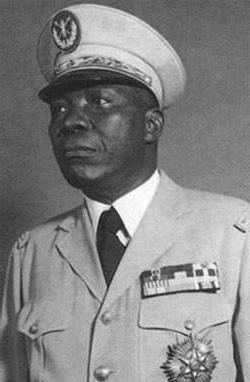Sangoulé Lamizana facts for kids
Quick facts for kids
Sangoulé Lamizana
|
|
|---|---|
 |
|
| 2nd President of Upper Volta | |
| In office 3 January 1966 – 25 November 1980 |
|
| Prime Minister | Gérard Kango Ouédraogo Himself Joseph Conombo Saye Zerbo |
| Preceded by | Maurice Yaméogo |
| Succeeded by | Saye Zerbo |
| 2nd Prime Minister of Upper Volta | |
| In office 8 February 1974 – 7 July 1978 |
|
| President | Himself |
| Preceded by | Gérard Kango Ouédraogo |
| Succeeded by | Joseph Conombo |
| Personal details | |
| Born | 31 January 1916 Dianra |
| Died | 26 May 2005 (aged 89) Ouagadougou, Burkina Faso |
| Political party | Independent |
| Children | Mariam Lamizana |
| Signature |  |
Aboubakar Sangoulé Lamizana (born January 31, 1916 – died May 26, 2005) was an important military leader from a country in West Africa called Upper Volta. This country is now known as Burkina Faso. He was the President of Upper Volta for many years, from 1966 to 1980. For some of that time, he also served as the Prime Minister.
Contents
Becoming President
Upper Volta became fully independent from France in 1960. After this, the country had only one main political party, the Union démocratique voltaïque (UDV). Maurice Yaméogo was the President.
However, many people were unhappy with President Yaméogo's rule. Students, workers, and government employees held strikes and protests. Because of these big protests and a military takeover, President Yaméogo had to step down on January 3, 1966. General Sangoulé Lamizana then took power, as the people wanted.
Leading the Country
Lamizana first led a "temporary military government." In 1970, a new set of rules for the country, called a Constitution, was approved. This Constitution planned for the country to return to being led by elected civilians after four years.
Lamizana also worked as the foreign minister from 1966 to 1967. This job involved dealing with other countries.
Facing Challenges
In the early 1970s, Upper Volta and other countries in the Sahel region faced a big problem: a five-year drought. This long period without rain caused the land to become like a desert, threatening a severe food shortage.
This economic difficulty led to disagreements within the government. The Prime Minister, Gérard Kango Ouédraogo, had been chosen by Lamizana. But because of the problems, the military stepped in again in 1974. Lamizana took full control, becoming the country's leader once more.
International Relations
Lamizana's government was recognized by other countries around the world. He even met with U.S. President Richard Nixon.
On October 15, 1973, Lamizana visited President Nixon in the Oval Office. He explained the serious drought in the Sahel region. Lamizana hoped to get help for Upper Volta and other affected countries. President Nixon promised to provide as much aid as he could.
Later Years and Overthrow
Lamizana had his own political group for a short time. In 1977, a new Constitution was written and approved by the people.
In 1978, Lamizana was re-elected in a public election. Many people believe this election was one of the fairest ever held in West Africa. Later, Lamizana joined the UDV party.
However, in November 1980, Colonel Saye Zerbo led a military takeover. This time, it was peaceful, and Lamizana was removed from power.
See also
- 1966 Upper Voltan coup d'état
 In Spanish: Aboubacar Sangoulé Lamizana para niños
In Spanish: Aboubacar Sangoulé Lamizana para niños

